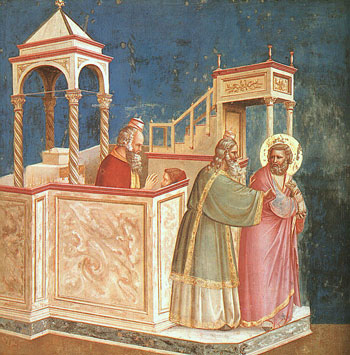
John
W. Dixon, Jr., Art
as a Means of Thinking and of Grace

We should not leave the account with just one of the
many paintings in the chapel. Part of the use and significance of
Giotto is his range as well as depth, the adaptability of his instruments
to the particular situation.
Take the first of the series, the Expulsion of Joachim
from the Temple. Joachim, soon to be the father of Mary, is expelled
from the temple because he and Anna are childless, therefore clearly
out of favor with God. Following his usual compositional procedure,
Giotto has established a rhythm of strong verticals across the surface,
fitting the stable, massive figures into the pattern of those verticals.
Consequentially, the inclination of the priest’s upper body has
great propulsive force as he disdainfully thrusts Joachim away from
the temple, intensified by the differing positions of his hands. Enclosed
protectively within the choir walls, a young man receives the blessing
of another priest. The priest is pushing Joachim into the loneliness
of the empty space at the side, perhaps the most dramatic emptiness
in western painting. In Giotto’s characteristic fashion, the
story has been reduced to its absolute essentials and represented
with dramatic precision.



